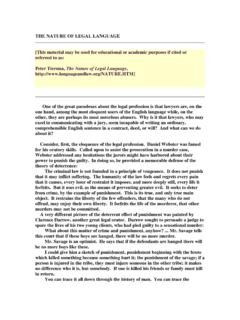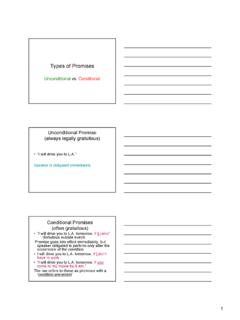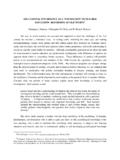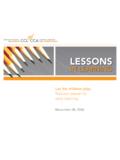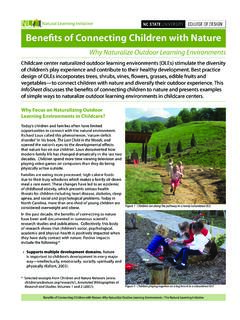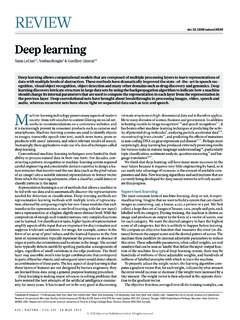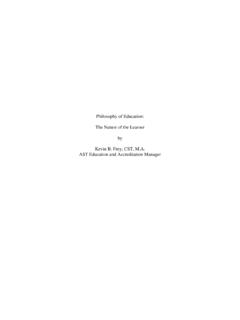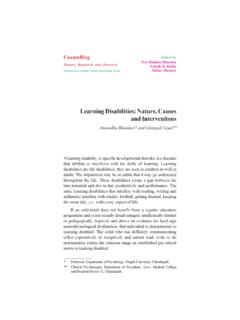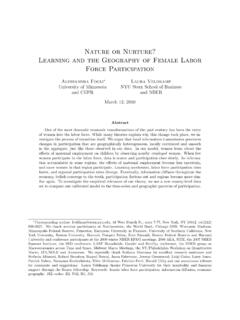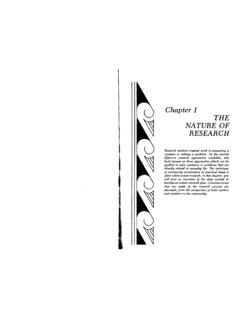Transcription of ON THE NATURE AND NURTURE OF LANGUAGE - …
1 ON THE NATURE AND NURTURE OF LANGUAGEE lizabeth BatesUniversity of California, San DiegoSupport for the work described here has been provided by NIH/NIDCD-R01-DC00216 ( Cross-linguistic studies in aphasia ), NIH-NIDCD P50 DC1289-9351 ( Origins of communicationdisorders ), NIH/NINDS P50 NS22343 ( Center for the Study of the Neural Bases of Languageand learning ), NIH 1-R01-AG13474 ( Aging and Bilingualism ), and by a grant from the JohnD. and Catherine T. MacArthur Foundation Research Network on Early Childhood address all correspondence to Elizabeth Bates, Center for Research in LANGUAGE 0526,University of California at San Diego, La Jolla, CA 92093-0526, or THE NATURE AND NURTURE OF LANGUAGEE lizabeth BatesLanguage is the crowning achievement of thehuman species, and it is something that all normalhumans can do.
2 The average man is neither aShakespeare nor a Caravaggio, but he is capable offluent speech, even if he cannot paint at all. In fact, theaverage speaker produces approximately 150 words perminute, each word chosen from somewhere between20,000 and 40,000 alternatives, at error rates The average child is already well on her waytoward that remarkable level of performance by 5 yearsof age, with a vocabulary of more than 6000 words andproductive control over almost every aspect of soundand grammar in her LANGUAGE . Given the magnitude of this achievement, and thespeed with which we attain it, some theorists haveproposed that the capacity for LANGUAGE must be builtdirectly into the human brain, maturing like an arm or akidney.
3 Others have proposed instead that we havelanguage because we have powerful brains that can learnmany things, and because we are extraordinarily socialanimals who value communication above everythingelse. Is LANGUAGE innate? Is it learned? Or, alterna-tively, does LANGUAGE emerge anew in every generation,because it is the best solution to the problems that wecare about, problems that only humans can solve?These are the debates that have raged for centuries in thevarious sciences that study LANGUAGE . They are alsovariants of a broader debate about the NATURE of the mindand the process by which minds are constructed inhuman children. The first position is called nativism , defined asthe belief that knowledge originates in human idea goes back to Plato and Kant, but in moderntimes it is most clearly associated with the linguistNoam Chomsky (see photograph).
4 Chomsky s viewson this matter are very strong indeed, starting with hisfirst book in 1957, and repeated with great consistencyfor the next 40 years. Chomsky has explicated the tiebetween his views on the innateness of LANGUAGE andPlato's original position on the NATURE of mind, asfollows:"How can we interpret [Plato's] proposal inmodern terms? A modern variant would be thatcertain aspects of our knowledge and understandingare innate, part of our biological endowment,genetically determined, on a par with the elementsof our common NATURE that cause us to grow armsand legs rather than wings. This version of theclassical doctrine is, I think, essentially correct.
5 "(Chomsky, 1988, p. 4)He has spent his career developing an influentialtheory of grammar that is supposed to describe theuniversal properties underlying the grammars of everylanguage in the world. Because this Universal Grammaris so abstract, Chomsky believes that it could not belearned at all, stating that Linguistic theory, the theory of UG[Universal Grammar].. is an innate property of thehuman [and].. the growth of LANGUAGE [is]analogous to the development of a bodily organ . Of course Chomsky acknowledges that Frenchchildren learn French words, Chinese children learnChinese words, and so on. But he believes that theabstract underlying principles that govern LANGUAGE arenot learned at all, arguing that A general learningtheory.
6 Seems to me dubious, unargued, and withoutany empirical support .Because this theory has been so influential inmodern linguistics and psycholinguistics, it is impor-tant to understand exactly what Chomsky means by innate. Everyone would agree that there is somethingunique about the human brain that makes languagepossible. But in the absence of evidence to thecontrary, that something could be nothing other thanthe fact that our brains are very large, a giant all-purpose computer with trillions of processing s version of the theory of innateness is muchstronger than the big brain view, and involves twologically and empirically separate claims: that languageis innate, and that our brains contain a dedicated,special-purpose learning device that has evolved forlanguage alone.
7 The latter claim is the one that isreally controversial, a doctrine that goes under variousnames including domain specificity , autonomy and modularity . The second position is called empiricism , definedas the belief that knowledge originates in theenvironment, and comes in through the senses. Thisapproach (also called behaviorism and associa-tionism ) is also an ancient one, going back (at least) toAristotle, but in modern times it is closely associatedwith the psychologist Skinner (see photograph). According to Skinner, there are no limits to what ahuman being can become, given time, opportunity andthe application of very general laws of are capable of LANGUAGE because we have thetime, the opportunity and (perhaps) the computingpower that is required to learn 50,000 words and theassociations that link those words together.
8 Much ofthe research that has taken place in linguistics,psycholinguistics and neurolinguistics since the 1950 shas been dedicated to proving Skinner wrong, byshowing that children and adults go beyond their input,creating novel sentences and (in the case of normalchildren and brain-damaged adults) peculiar errors thatthey have never heard before. Chomsky himself hasbeen severe in his criticisms of the behaviorist approachto LANGUAGE , denouncing those who believe that3language can be learned as grotesquely wrong (Gelman, 1986). In their zealous attack on the behaviorist approach,nativists sometimes confuse Skinner s form ofempiricism with a very different approach, alternativelycalled interactionism , constructivism, and emer-gentism.
9 This is a much more difficult idea than eithernativism or empiricism, and its historical roots are lessclear. In the 20th century, the interactionist orconstructivist approach has been most closely associatedwith the psychologist Jean Piaget (see photograph).More recently, it has appeared in a new approach tolearning and development in brains and brain-likecomputers alternatively called connectionism, paral-lel distributed processing and neural networks (Elman et al., 1996; Rumelhart & McClelland, 1986),and in a related theory of development inspired by thenonlinear dynamical systems of modern physics (Thelen& Smith, 1994). To understand this difficult butimportant idea, we need to distinguish between twokinds of interactionism: simple interactions (black andwhite make grey) and emergent form (black and whiteget together and something altogether new and differenthappens).
10 In an emergentist theory, outcomes can arise forreasons that are not obvious or predictable from any ofthe individual inputs to the problem. Soap bubbles areround because a sphere is the only possible solution toachieving maximum volume with minimum surface( , their spherical form is not explained by the soap,the water, or the little boy who blows the bubble). Thehoneycomb in a beehive takes an hexagonal formbecause that is the stable solution to the problem ofpacking circles together ( , the hexagon is notpredictable from the wax, the honey it contains, norfrom the packing behavior of an individual bee seeFigure 1). Jean Piaget argued that logic and knowledgeemerge in just such a fashion, from successiveinteractions between sensorimotor activity and astructured world.
